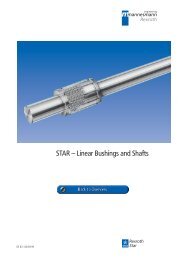STAR – Precision Ball Screw Assemblies
STAR – Precision Ball Screw Assemblies
STAR – Precision Ball Screw Assemblies
Create successful ePaper yourself
Turn your PDF publications into a flip-book with our unique Google optimized e-Paper software.
<strong>STAR</strong> <strong>–</strong> <strong>Precision</strong> <strong>Ball</strong> <strong>Screw</strong> <strong>Assemblies</strong><br />
End Bearings, Calculation<br />
Resulting and equivalent<br />
bearing loads<br />
Angular contact thrust ball bearings are<br />
preloaded. The chart shows the resulting<br />
axial bearing load Fa as a function of<br />
preload and axial operating load FaB zeigt<br />
das Diagramm.<br />
If the system is primarily subject to axial<br />
operating loads, then F = Fa .<br />
α = 60° X Y<br />
Fa Fr<br />
Fa Fr<br />
≤ 2.17<br />
> 2.17<br />
1.9 0.55<br />
0.92 1<br />
α = pressure angle<br />
X, Y= dimensionless factor<br />
Fa = resulting bearing load<br />
FaB = operating load<br />
If the radial operating forces are not<br />
insignificant, the equivalent bearing loads<br />
are calculated according to formula 20 .<br />
Bearings for ball screw assemblies are also<br />
able to accommodate tilting moments. As<br />
a rule, the moments that usually occur due<br />
to the weight and drive motion of the<br />
screw do not need to be incorporated in<br />
the calculation of the equivalent bearing<br />
load.<br />
F = X · F r + Y · F a<br />
20<br />
Internal preload limit and resulting<br />
bearing load<br />
RResulting bearing load F a (N)<br />
18000<br />
17000<br />
16000<br />
15000<br />
14000<br />
13000<br />
12000<br />
11000<br />
10000<br />
9000<br />
8000<br />
7000<br />
6000<br />
5000<br />
4000<br />
3000<br />
2000<br />
1000<br />
d = 10<br />
d = 6<br />
1) Four row version<br />
d = 17<br />
d = 12<br />
d = 20<br />
2000 4000 6000<br />
d = 35<br />
d = 30<br />
Limits<br />
F r = radial bearing load (N)<br />
F a = resulting axial bearing load (N)<br />
F = equivalent bearing load (N)<br />
d=25 10<br />
8000 10000 12000<br />
Operating load FaB (N)<br />
100 RE 83 301/12.99<br />
1)<br />
d=30 1)<br />
d=40<br />
d=50<br />
14000 16000 18000



